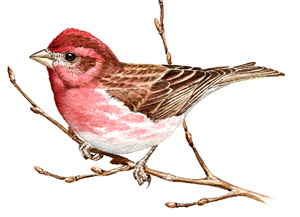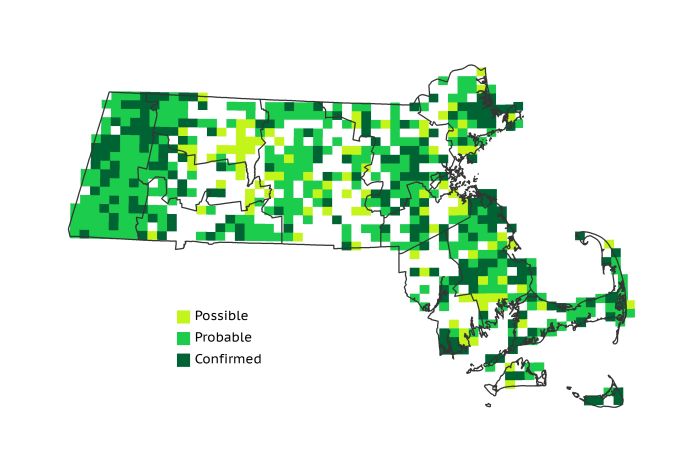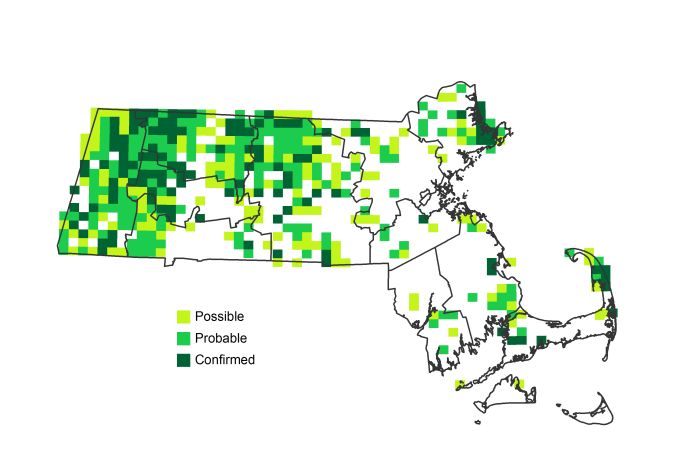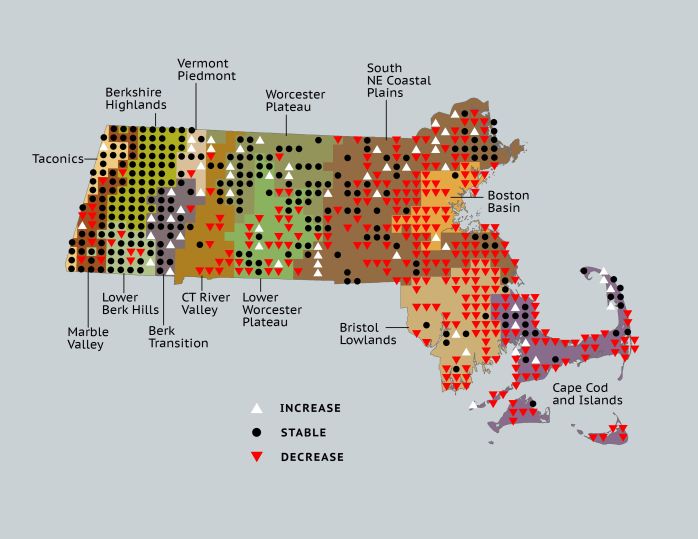Breeding Bird Atlases (BBA)
Find a Bird
Purple Finch
Carpodacus purpureus

Fairly widespread and strongly declining
Conservation action urgent
“The purple piper plays his tune, / The choir softly sing; / Three lullabies in an ancient tongue, / For the court of the crimson king.” – Peter Sinfield, “The Court of the Crimson King”
The Purple Finch was a common and well-known nester throughout the northern forests of the Americas, and it is sadly diminished in recent years. The complex color pallet of pale red-violet hues of a male Purple Finch’s feathers comes from a diet rich in carotenoids – pigments derived from their diet of buds, flowers, seeds, and insects. Purple Finches prefer to breed at the edges of forests, and in orchard or park-like settings throughout the Commonwealth. For this species the decline without good evidence of the primary villain – was it habitat loss or the House Finch, or some other villain that has forced the Purple Finch into a struggle – is a struggle it appears to be losing.
Historic Status
The Crimson Linnet, or Purple Finch, apparently existed in Massachusetts for centuries. Primarily known as a migrant, it nevertheless also nested in the Bay State as long ago as the 1830s. General Henry Dearborn, a hero of both the Revolution and the War of 1812, was the first to find its nest, “on the low branch of a balsam fir, with the outside covered with lichens” (Peabody 1839). Throughout most of the nineteenth century, the species’ story was one of abundance and near ubiquity. However, in the late years of that century the species began to exhibit nomadic tendencies and irruptive behavior (Howe & Allen 1901). The arrival of House Sparrows did the species no favors (Brewster 1906), and the Purple Finch also experienced unexpected competition with the arrival of the invasive introduced House Finch (Wootton 1996).
Atlas 1 Distribution
During Atlas 1 Purple Finches were still widespread (64% of the blocks surveyed) in Massachusetts, but their distribution was not as continuous as it was historically. The western hill country in the Berkshires still maintained nearly complete block occupancy. Breeding concentrations waned through the Berkshire Transition, and the species was present, but local, in the largely agricultural Connecticut River Valley. Areas of suitable woodland habitat throughout the Worcester Plateau regions showed signs of breeding Purple Finches, even though relatively few were Confirmed. Purple Finches were fairly uniform from the Coastal Plains east, with block occupancy rates ranging from 54% to 60%.
Atlas 2 Distribution and Change
There has been a remarkable decline in the distribution of the Purple Finch, reducing this once fairly common breeder to a fraction of its range in a mere 35 years. Its distribution in Atlas 1 was comparatively robust, inhabiting conifers in both natural and planted settings, and occupying the pine barrens of the Bristol Lowlands and Cape Cod regions. By the time of Atlas 2, the Purple Finch was apparently extirpated from much of its former range in the state, and reduced to 43% of the state. The western regions fared the best, with the Taconics, Vermont Piedmont, Berkshire Transition, and Worcester Plateau regions all showing a net gain for this species. Unfortunately, the good news stops there, since all the remaining regions in the state to the east and south posted large losses in the percent of blocks occupied for this species.
Atlas 1 Map

Atlas 2 Map

Atlas Change Map

Ecoregion Data
Atlas 1 | Atlas 2 | Change | ||||||
Ecoregion | # Blocks | % Blocks | % of Range | # Blocks | % Blocks | % of Range | Change in # Blocks | Change in % Blocks |
Taconic Mountains | 14 | 87.5 | 2.3 | 20 | 80.0 | 4.5 | 1 | 6.7 |
Marble Valleys/Housatonic Valley | 38 | 97.4 | 6.1 | 31 | 79.5 | 7.0 | -7 | -17.9 |
Berkshire Highlands | 54 | 98.2 | 8.7 | 54 | 98.2 | 12.2 | -1 | -1.9 |
Lower Berkshire Hills | 27 | 96.4 | 4.4 | 23 | 74.2 | 5.2 | -4 | -14.8 |
Vermont Piedmont | 9 | 52.9 | 1.5 | 15 | 88.2 | 3.4 | 3 | 25.0 |
Berkshire Transition | 25 | 65.8 | 4.0 | 34 | 85.0 | 7.7 | 7 | 22.6 |
Connecticut River Valley | 19 | 33.9 | 3.1 | 11 | 16.9 | 2.5 | -11 | -22.9 |
Worcester Plateau | 51 | 65.4 | 8.2 | 78 | 88.6 | 17.7 | 4 | 8.3 |
Lower Worcester Plateau | 51 | 68.9 | 8.2 | 39 | 48.8 | 8.8 | -18 | -33.3 |
S. New England Coastal Plains and Hills | 159 | 58.9 | 25.6 | 94 | 33.2 | 21.3 | -74 | -32.7 |
Boston Basin | 30 | 53.6 | 4.8 | 2 | 3.6 | 0.5 | -28 | -50.9 |
Bristol and Narragansett Lowlands | 63 | 59.4 | 10.2 | 10 | 8.8 | 2.3 | -51 | -50.5 |
Cape Cod and Islands | 80 | 58.8 | 12.9 | 30 | 20.8 | 6.8 | -48 | -40.0 |
Statewide Total | 620 | 64.0 | 100.0 | 441 | 42.5 | 100.0 | -227 | -27.4 |
Notes
The Purple Finch shows a significant decreasing Breeding Bird Survey trend in Massachusetts, in the New England/Mid-Atlantic Region, and in the Eastern US overall. To date there is little expectation of recovery for this species because there is little work being done to help the species. The role of House Finch competition in the decline of this species is not well understood, but this species also is declining in areas where the House Finch is not common.



